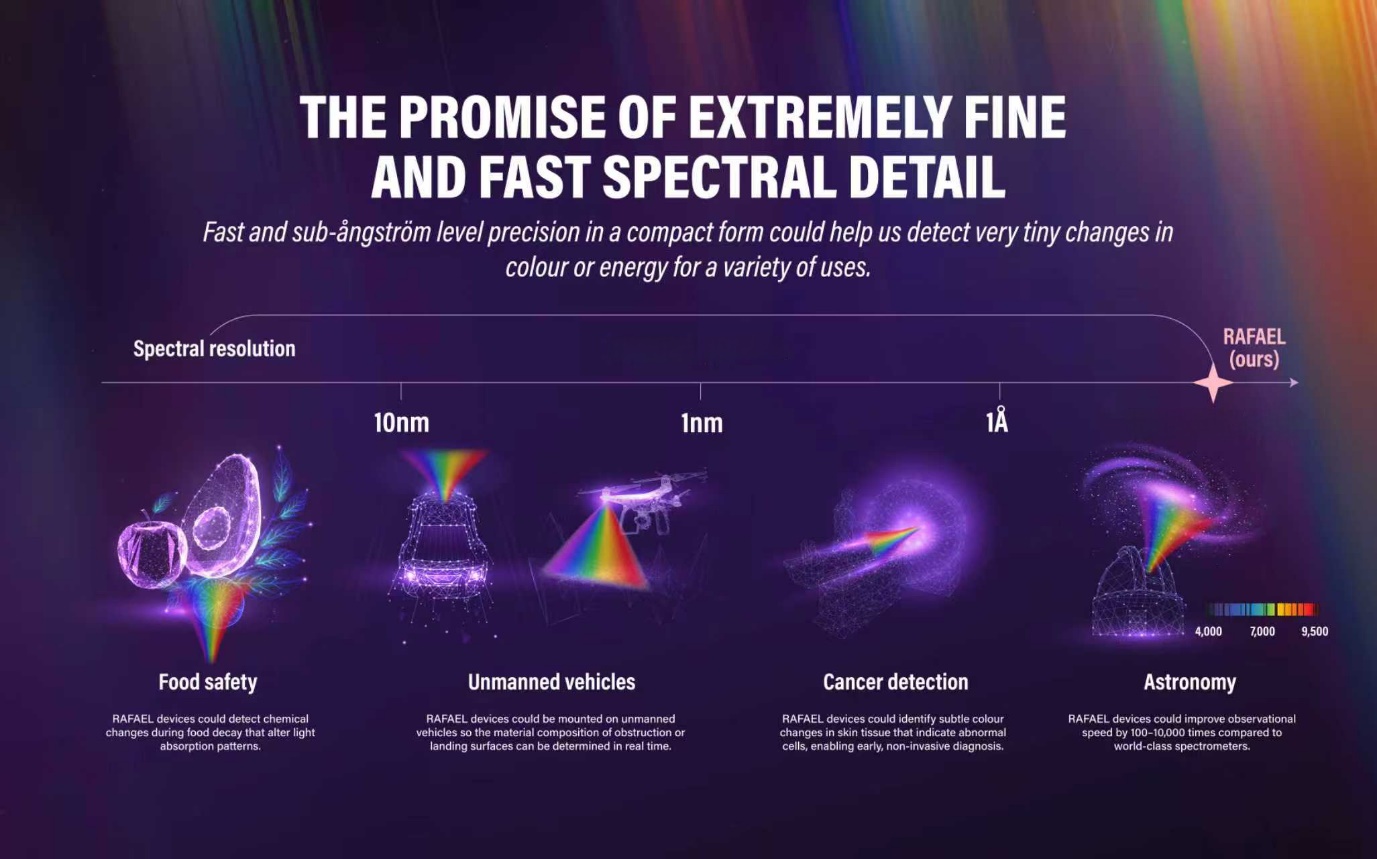
Caption: A new, small spectrometer with sub-ångström sensitivity can detect incredibly subtle differences in colors of light or energy, unlocking a number of fascinating uses. Credit: Tsinghua University
Spectroscopy so tiny it could be added to a phone can decode incredibly subtle shifts in light, to detect fruit freshness, or skin anomalies, or map thousands of stars a second.
You point your phone at a pear. Not only do you snap its image, but a spectral scan also reveals whether it’s unripe or perfectly sweet. That same tech could flag a suspicious mole before your doctor does, or help survey billions of stars in a galaxy.
A device that does this with previously unmatched speed and accuracy may soon be on the horizon thanks to a new Tsinghua University developed spectrometer that was described in Nature in October 20251. The spectrometer, dubbed RAFAEL, is a small sensor chip able to capture rich light or other electromagnetic radiation details with a wavelength resolution of 0.5 angstroms and high sensitivity.
To give you an idea of what that means: the smallest wavelength details RAFAEL can detect are 0.5 angstroms, which are 1.6 million times smaller than a hair’s thickness. That means the device can detect incredibly subtle differences in colors of light or energy, potentially helping identify early signs of skin issues, chemical compositions, and material defects invisible to the naked eye.
Importantly, it’s a chip-based solution that’s small, integrates with microelectronics, and can potentially be mass produced.
Smaller solutions
Spectrometers that capture this level of detail today are usually bulky, expensive lab instruments that measure up to one meter across, with slow response times.
In contrast, the current spectrometer chip was designed by computational imaging specialist, Lu Fang, and her team at Tsinghua, to offer high performance in devices as small as a smartphone.
The chips have no moving parts and are based on a conventional CMOS (complementary metal-oxide-semiconductor) image sensor chips — semiconductor devices that convert light into digital images, commonly found in cameras.
CMOS chips are interfaced with a structure above: a thin film of electro-optical lithium niobate, sandwiched between two reflectors and a set of electrodes.
Mounted above the sensor, this lithium niobate layer acts like a smart filter. When voltage is applied, it modulates the spectral transmission profile, assigning different weights to different wavelengths that are integrated at the sensor.
It can do this differently across its surface, capturing the full spectrum of the scene beneath up to 88 times per second. The result is a camera that dynamically adjusts its sensitivity in real time.
Early prototypes already capture a wide range of light, from visible colors to near-infrared, using standard camera chips with 4 to 12 megapixels. Now, the team is developing a version that goes further: detecting light from 300 to 1700 nanometers, covering ultraviolet, visible, and deep infrared light.
With this broader range, RAFAEL could help identify substances, detect hidden features, or spot health and environmental changes by analyzing how light behaves.

Caption: Computational imaging specialist Lu Fang (middle) and her team at Tsinghua have developed an alternative to the expensive lab spectrometers that measure up to one meter across. Credit: Tsinghua University
Star turn
RAFAEL devices can be populated with millions, or tens of millions, of ultra-high precision spectrometers operating in parallel, explains Fang. “That brings you laboratory-grade spectroscopy into a chip.”
Astronomers worldwide have already expressed interest in the technology for star surveys and the hunt for exoplanets and dark matter. RAFAEL is expected to be trialed by several large telescope centers soon.
“RAFAEL can record the full spectra from nearly 10,000 stars per second,” Fang says. “For a Milky Way survey of nearly 200 billion stars, existing technology would take thousands of years. RAFAEL could cut that to a decade or less.”
Reference
1. Yao, Z., Liu, S., Wang, Y. et al. Integrated lithium niobate photonics for sub-ångström snapshot spectroscopy Nature 646, 567–575 (2025).